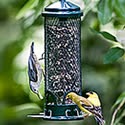 During the winter months there are many different backyard birds are easily attracted to a feeding station. Including chickadees, goldfinches, sparrows, nuthatches, blue jays and woodpeckers.
During the winter months there are many different backyard birds are easily attracted to a feeding station. Including chickadees, goldfinches, sparrows, nuthatches, blue jays and woodpeckers. Best Winter Bird feeders
To attract the greatest number of species in the winter, it is important to have a number of different bird feeders available.
Feeders will be most useful in the winter if they have a cover over feeding ports, perches and dispensing trays so seed is not buried during snowfalls or storms. Fly-through platform feeders are especially good designs for winter bird feeding.
Ideally, winter bird feeders should be placed in sheltered locations out of the most severe winds. Placing feeders closer to the house will be effective and will help keep the birds visible for indoor bird watching. At the same time, feeders should be placed near protective cover such as hedges or a brush pile to offer birds safety from predators. To minimize window collisions, place feeders no more than five feet away from a wall or window, and use window decals or other techniques to prevent collisions.
For birders’ convenience, large capacity feeders are preferred for winter feeding because they do not need to be refilled as frequently. This is only viable, however, if the seed is protected from moisture, otherwise it may grow mold before it is consumed. Covered feeders with large capacities are suitable, although platform feeders do not hold a lot of seeds they do allow more birds to feeds at the same time. Great when a flock of grosbeaks or finches come along.
Because natural food sources are scarcer in the winter, more birds may be attracted to backyard feeders and those feeders will need to be cleaned and sterilized regularly. Proper cleaning will minimize mold and other unhealthy conditions that could foster disease among backyard bird populations. When cleaning, discard soggy seed or seed encased in ice, and let the feeder dry before refilling if possible.
Foods for Birds in Winter
Most birds that visit backyards in snowy weather thrive on seeds, since insects and fruit are harder to find naturally during the winter. The best foods to offer birds in colder weather have a high fat or oil content that will provide abundant energy for winter survival.
Nutritious foods for birds include: Black oil sunflower, white millet, nyjer, peanut halves and peanuts in the shell!
Birds need to burn more calories in the winter just to stay warm. Suet is considered a good high energy food. Suet feeders are a favorite of woodpeckers and other insect-eating birds
When choosing birdseed and other foods for winter feeding, take into consideration which bird species are present in the winter and what foods they prefer to avoid excess wasted seed. Many birders also prefer to use no-mess seed mixes such as hulled sunflower seeds in the winter to avoid several months’ of hull accumulation beneath feeders in the spring.
To properly store seed, it should be kept in a cool, dry place that is protected from bugs and rodents. Choose a metal storage bin that will be easy to access all winter, and one that can be easily manipulated while wearing gloves and bulky coats.
More tips for winter bird feeding success:
- Clean off feeders, platforms and perches after each storm so seed is easily accessible.
- Leave fruit and berries on trees, hedges and bushes to provide a natural source of food throughout the winter.
- Add a heated birdbath to your backyard or place a safe heating element in a regular birdbath to provide birds with liquid water.
- Stamp or shovel snow around feeders to provide easier access to spilled seed for ground feeding birds.
- Leave nesting boxes and birdhouses up all year round to provide winter roosting sites.
With care and consideration, backyard birding can be an exhilarating hobby throughout the winter, with birdsong and backyard visits to brighten the coldest, darkest days of the season.



